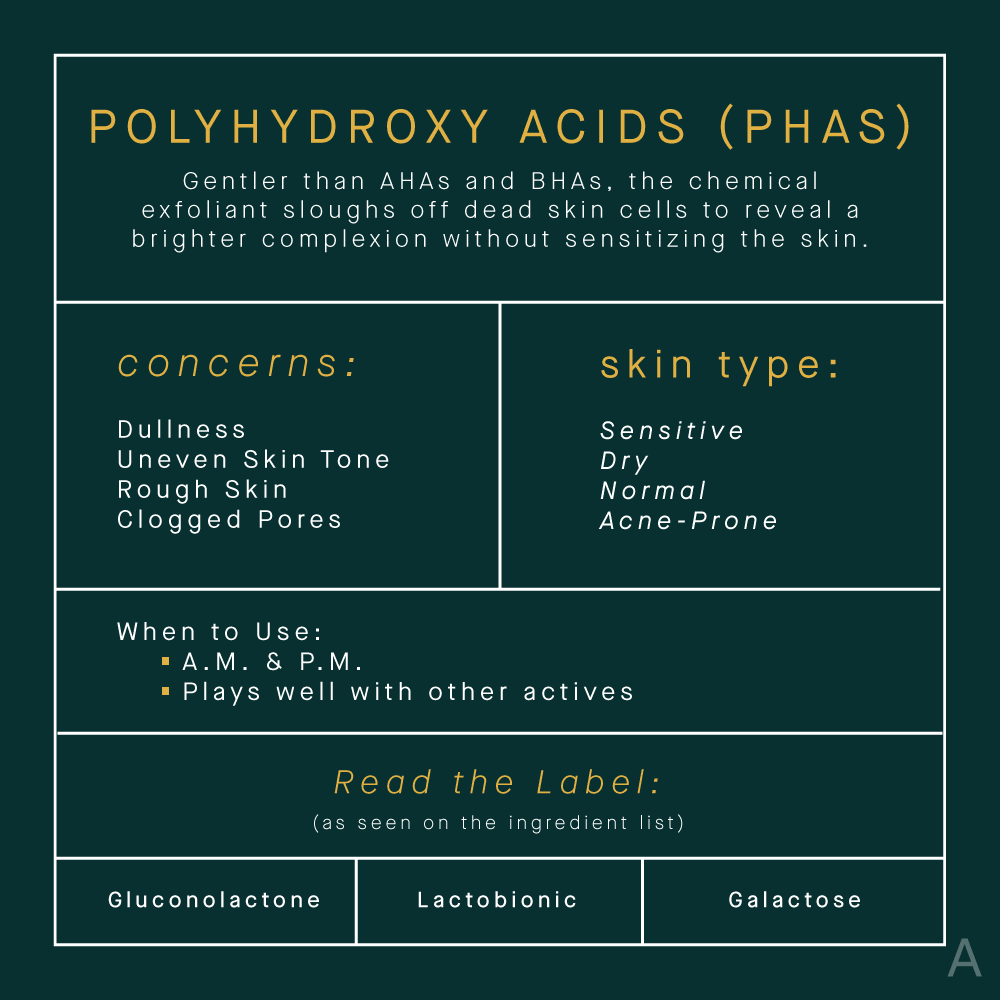What is PHA in skin care? PHA, or Polyhydroxy Acid, is a gentle chemical exfoliant that works to improve skin texture and tone. It’s often compared to AHAs and BHAs but is considered milder, making it suitable for sensitive skin. Keep reading to discover all the PHA benefits for skin and how they stack up against other popular exfoliants.

Image Source: res.cloudinary.com
Decoding PHAs: A Deep Dive into Polyhydroxy Acids
Polyhydroxy Acids (PHAs) are a class of chemical exfoliants gaining popularity in the skincare world. But what exactly are they, and what makes them different? PHAs are acids that exfoliate the skin’s surface, removing dead skin cells and promoting cell turnover. This process can lead to a brighter, smoother, and more even-toned complexion. But PHA benefits for skin extend beyond simple exfoliation.
The Science Behind Polyhydroxy Acid Exfoliation
The key to PHA’s gentle nature lies in its molecular structure. PHA molecules are larger than those of AHAs (Alpha Hydroxy Acids) and BHAs (Beta Hydroxy Acids). This larger size prevents them from penetrating the skin as deeply. Because they stay on the surface, they exfoliate without causing as much irritation.
Gluconolactone Skin Care: A Common PHA
One of the most common PHAs found in skincare products is gluconolactone. It’s derived from a naturally occurring sugar and offers a range of benefits beyond exfoliation. Gluconolactone skin care can also act as a humectant, drawing moisture to the skin, and an antioxidant, protecting the skin from free radical damage.
Lactobionic Acid Benefits: Another PHA Powerhouse
Another notable PHA is lactobionic acid. This ingredient is derived from lactose (milk sugar) and shares similar properties with gluconolactone. Lactobionic acid benefits include gentle exfoliation, hydration, and antioxidant protection. It’s also been shown to help improve skin firmness and elasticity.
PHA Benefits for Skin: More Than Just Exfoliation
PHAs offer a multi-faceted approach to skincare. Here are some of the key PHA benefits for skin:
- Gentle Exfoliation: Removes dead skin cells without causing significant irritation, making it a gentle chemical exfoliant.
- Hydration: Acts as a humectant, drawing moisture to the skin.
- Antioxidant Protection: Helps protect the skin from free radical damage.
- Improved Skin Texture: Promotes smoother, softer skin.
- Even Skin Tone: Reduces the appearance of hyperpigmentation and discoloration.
- PHA Anti-Aging: Can help improve skin firmness and elasticity.
- PHA Skin Resurfacing: Supports the natural skin renewal process.
PHA vs AHA: What’s the Real Difference?
AHAs (like glycolic and lactic acid) have long been staples in skincare for their exfoliating and anti-aging properties. So, how does PHA compare? The main difference lies in their molecular size and, consequently, their impact on the skin.
Molecular Size Matters
As mentioned earlier, PHA molecules are larger than AHA molecules. This difference affects how deeply they penetrate the skin. AHAs penetrate deeper, providing more intense exfoliation but also increasing the risk of irritation. PHAs, on the other hand, stay primarily on the surface, offering a milder form of exfoliation.
PHA vs AHA: A Comparison Table
| Feature | AHA (e.g., Glycolic Acid) | PHA (e.g., Gluconolactone) |
|---|---|---|
| Molecular Size | Smaller | Larger |
| Penetration | Deeper | More superficial |
| Exfoliation | More intense | Milder |
| Irritation Risk | Higher | Lower |
| Hydration | Moderate | High |
| Antioxidant | Lower | Higher |
| Best For | Normal to oily skin | Sensitive skin |
Choosing Between PHA and AHA
The choice between PHA and AHA depends on your skin type and sensitivity. If you have normal to oily skin and are looking for a more intense exfoliation, AHAs might be a good option. However, if you have sensitive skin or are prone to irritation, PHA is a gentler alternative.
PHA vs BHA: The Battle of the Exfoliants
BHAs (Beta Hydroxy Acids), like salicylic acid, are known for their ability to penetrate pores and dissolve oil and debris. This makes them particularly effective for treating acne and blackheads. How does PHA stack up against BHA?
Targeting Different Skin Concerns
While both PHAs and BHAs exfoliate, they target different skin concerns. BHAs are oil-soluble, meaning they can penetrate the pores. PHAs are water-soluble and primarily exfoliate the skin’s surface.
PHA for Sensitive Skin: A Viable Option
One of the key advantages of PHA is its suitability for sensitive skin. Because it doesn’t penetrate as deeply as BHAs, it’s less likely to cause irritation. This makes it a great option for those with sensitive or reactive skin who still want to experience the benefits of exfoliation.
PHA vs BHA: A Quick Overview
| Feature | BHA (e.g., Salicylic Acid) | PHA (e.g., Gluconolactone) |
|---|---|---|
| Solubility | Oil-soluble | Water-soluble |
| Penetration | Deep, into pores | More superficial |
| Exfoliation Target | Pores and surface | Surface |
| Best For | Acne-prone, oily skin | Sensitive skin |
Combining PHAs with AHAs/BHAs
In some cases, PHAs can be combined with AHAs or BHAs. The PHA can act as a buffer, reducing the irritation caused by the stronger acid. This approach requires careful consideration and is best done under the guidance of a dermatologist or skincare professional.
Who Should Use PHAs? Identifying the Ideal Candidate
PHAs are a versatile ingredient suitable for a wide range of skin types. However, they are particularly beneficial for certain individuals.
PHA for Sensitive Skin: A Gentle Solution
People with sensitive skin often struggle to find effective exfoliants that don’t cause irritation. PHA is an excellent option because its larger molecular size minimizes penetration and reduces the risk of sensitivity.
Dry and Dehydrated Skin: A Hydrating Exfoliant
The humectant properties of PHAs make them a great choice for dry and dehydrated skin. They can help to draw moisture into the skin, improving hydration levels while gently exfoliating.
Rosacea and Eczema: A Calming Choice
Individuals with rosacea or eczema often have compromised skin barriers and are prone to inflammation. PHAs can be a gentler alternative to AHAs and BHAs, offering exfoliation without exacerbating these conditions.
Mature Skin: Addressing Multiple Concerns
The PHA anti-aging benefits are also noteworthy. Mature skin can benefit from the gentle exfoliation, hydration, and antioxidant protection that PHAs provide. They can help to improve skin texture, even out skin tone, and protect against environmental damage.
Integrating PHAs into Your Skincare Routine: A Step-by-Step Guide
Adding PHAs to your skincare routine is a simple process. Here’s a step-by-step guide to help you get started:
- Start Slowly: Begin by using a PHA product once or twice a week. This allows your skin to adjust to the exfoliant and minimizes the risk of irritation.
- Choose the Right Product: PHAs are available in various formulations, including cleansers, toners, serums, and creams. Select a product that aligns with your skincare goals and preferences.
- Apply After Cleansing: After cleansing your skin, apply the PHA product according to the product instructions.
- Follow with Moisturizer: Because PHAs can draw moisture to the skin, it’s essential to follow with a moisturizer to lock in hydration.
- Use Sunscreen: Exfoliation can make your skin more sensitive to the sun. Apply a broad-spectrum sunscreen with an SPF of 30 or higher every morning.
- Observe Your Skin: Pay attention to how your skin responds to the PHA. If you experience any irritation, reduce the frequency of use or discontinue the product.
Popular PHA Products: A Curated Selection
- Toner: Glow Recipe Watermelon Glow PHA + BHA Pore-Tight Toner
- Serum: The Ordinary PHA 12% + HA
- Cream: NeoStrata Bio-Hydrating Cream
Potential Side Effects: What to Watch Out For
While PHAs are generally well-tolerated, some people may experience mild side effects, especially when first starting to use them.
- Redness: Mild redness can occur, particularly in sensitive skin.
- Dryness: While PHAs are hydrating, some people may experience temporary dryness.
- Stinging: A slight stinging sensation can occur upon application.
If you experience any severe side effects, such as significant irritation, swelling, or blistering, discontinue use and consult a dermatologist.
Expert Tips for Maximizing PHA Benefits
- Patch Test: Before incorporating a PHA product into your routine, perform a patch test on a small area of skin to check for any adverse reactions.
- Combine with Hydrating Ingredients: Pair PHA products with other hydrating ingredients, such as hyaluronic acid or ceramides, to maximize moisture retention.
- Listen to Your Skin: Pay attention to how your skin feels and adjust your routine accordingly. If your skin feels dry or irritated, reduce the frequency of use.
- Consult a Dermatologist: If you have any concerns or questions about using PHAs, consult a dermatologist for personalized advice.
PHA Skin Resurfacing: Unveiling a Fresh Complexion
PHA skin resurfacing promotes the shedding of dead skin cells on the surface. This process helps reveal fresher, more radiant skin underneath. The term “resurfacing” refers to the renewal of the skin’s outermost layer, which can lead to improved texture, tone, and overall appearance.
FAQ: Your Burning Questions About PHAs Answered
Can I use PHA every day?
Yes, you can use PHA every day, especially if you have sensitive skin. However, start slowly and observe how your skin responds.
What is the best PHA for anti-aging?
Both gluconolactone and lactobionic acid offer anti-aging benefits. Look for products that contain either of these ingredients.
Who is the best candidate for using PHA?
The best candidates are those with sensitive, dry, or reactive skin. However, anyone can benefit from PHA, especially those looking for gentle exfoliation.
Is PHA better than retinol?
PHA and retinol serve different purposes. Retinol is a potent anti-aging ingredient that works deep within the skin, while PHA is a gentle exfoliant that works on the surface. They can be used together, but it’s essential to introduce them slowly and monitor your skin for irritation.
Are there any ingredients that should not be combined with PHA?
Avoid combining PHA with other strong exfoliants, such as high concentrations of AHAs or BHAs, unless directed by a dermatologist. This can minimize the risk of over-exfoliation and irritation.
By adding PHA to your skincare arsenal, you can achieve smoother, brighter, and more hydrated skin. Remember to start slowly, choose the right products, and listen to your skin’s needs. With a little patience and consistency, you can unlock the full potential of this gentle yet effective exfoliant.

I’m Carrie Kelly, the creator behind Gotham Beauty Lounge. Beauty is my passion, and I’ve made it my mission to bring you all the latest trends, expert tips, and honest reviews to help you elevate your beauty game. With a love for all things bold, edgy, and elegant, I believe makeup is an art form, and skincare is self-care. On my blog, I share my personal experiences, favorite products, and advice for embracing your unique beauty. Join me on this exciting journey to feel confident, empowered, and, most importantly, to always look and feel your best!
